Gender Disparity in UK Rape Laws: A Critical Analysis
VerifiedAdded on 2023/06/17
|16
|6394
|380
AI Summary
This dissertation critically analyzes the presence of gender disparity in the UK rape laws, its reasons, and ways to minimize it. It evaluates the current rape law in the UK and the presence of gender disparity in it. The main research question is 'Is there a gender disparity in the UK rape laws?' The literature review focuses on the current rape law in the UK and the presence of gender disparity in it. The subject is criminal law, and the course code is not mentioned. The course name and college/university are not mentioned.
Contribute Materials
Your contribution can guide someone’s learning journey. Share your
documents today.

DISSERTATION
Secure Best Marks with AI Grader
Need help grading? Try our AI Grader for instant feedback on your assignments.
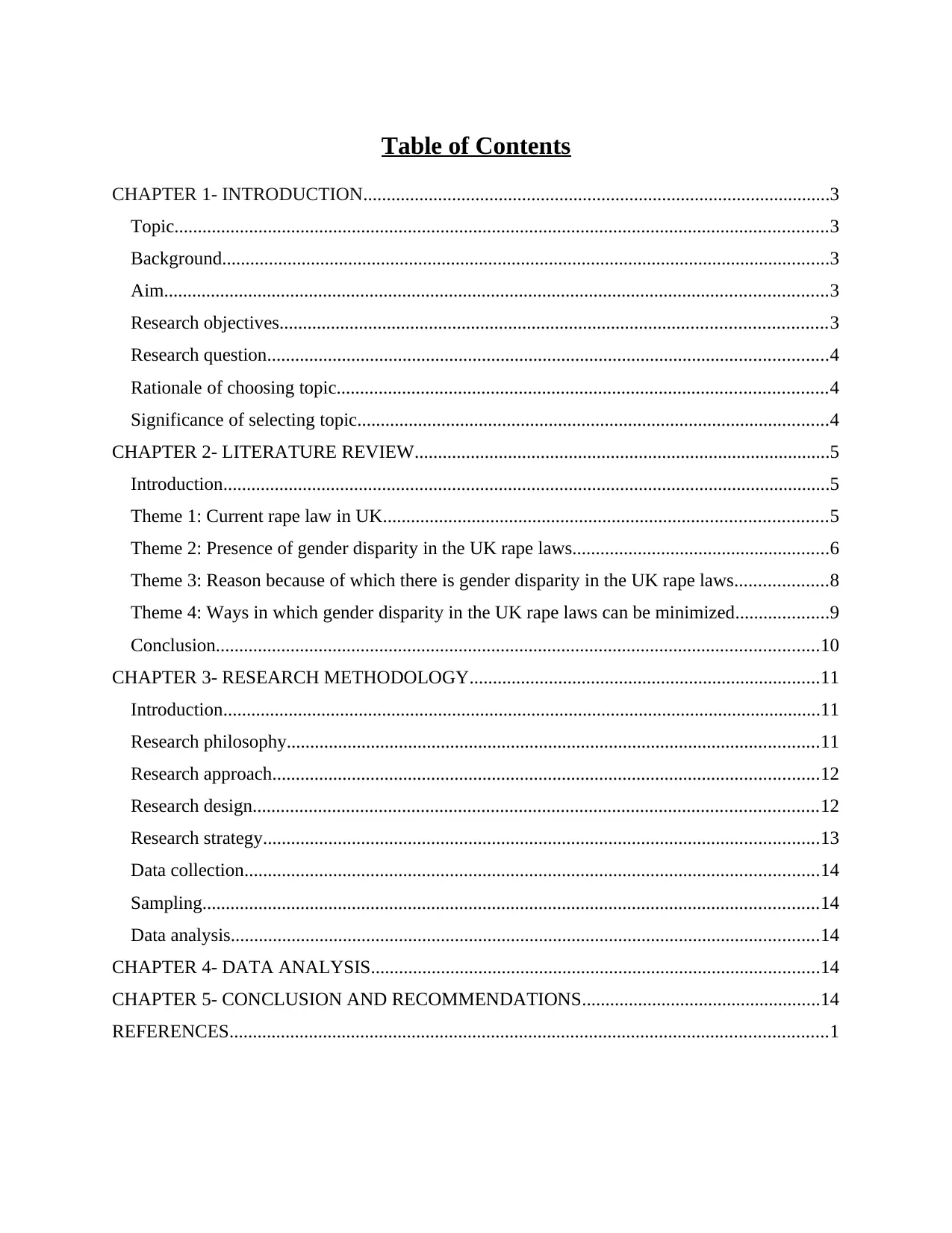
Table of Contents
CHAPTER 1- INTRODUCTION....................................................................................................3
Topic............................................................................................................................................3
Background..................................................................................................................................3
Aim..............................................................................................................................................3
Research objectives.....................................................................................................................3
Research question........................................................................................................................4
Rationale of choosing topic.........................................................................................................4
Significance of selecting topic.....................................................................................................4
CHAPTER 2- LITERATURE REVIEW.........................................................................................5
Introduction..................................................................................................................................5
Theme 1: Current rape law in UK...............................................................................................5
Theme 2: Presence of gender disparity in the UK rape laws.......................................................6
Theme 3: Reason because of which there is gender disparity in the UK rape laws....................8
Theme 4: Ways in which gender disparity in the UK rape laws can be minimized....................9
Conclusion.................................................................................................................................10
CHAPTER 3- RESEARCH METHODOLOGY...........................................................................11
Introduction................................................................................................................................11
Research philosophy..................................................................................................................11
Research approach.....................................................................................................................12
Research design.........................................................................................................................12
Research strategy.......................................................................................................................13
Data collection...........................................................................................................................14
Sampling....................................................................................................................................14
Data analysis..............................................................................................................................14
CHAPTER 4- DATA ANALYSIS................................................................................................14
CHAPTER 5- CONCLUSION AND RECOMMENDATIONS...................................................14
REFERENCES................................................................................................................................1
CHAPTER 1- INTRODUCTION....................................................................................................3
Topic............................................................................................................................................3
Background..................................................................................................................................3
Aim..............................................................................................................................................3
Research objectives.....................................................................................................................3
Research question........................................................................................................................4
Rationale of choosing topic.........................................................................................................4
Significance of selecting topic.....................................................................................................4
CHAPTER 2- LITERATURE REVIEW.........................................................................................5
Introduction..................................................................................................................................5
Theme 1: Current rape law in UK...............................................................................................5
Theme 2: Presence of gender disparity in the UK rape laws.......................................................6
Theme 3: Reason because of which there is gender disparity in the UK rape laws....................8
Theme 4: Ways in which gender disparity in the UK rape laws can be minimized....................9
Conclusion.................................................................................................................................10
CHAPTER 3- RESEARCH METHODOLOGY...........................................................................11
Introduction................................................................................................................................11
Research philosophy..................................................................................................................11
Research approach.....................................................................................................................12
Research design.........................................................................................................................12
Research strategy.......................................................................................................................13
Data collection...........................................................................................................................14
Sampling....................................................................................................................................14
Data analysis..............................................................................................................................14
CHAPTER 4- DATA ANALYSIS................................................................................................14
CHAPTER 5- CONCLUSION AND RECOMMENDATIONS...................................................14
REFERENCES................................................................................................................................1
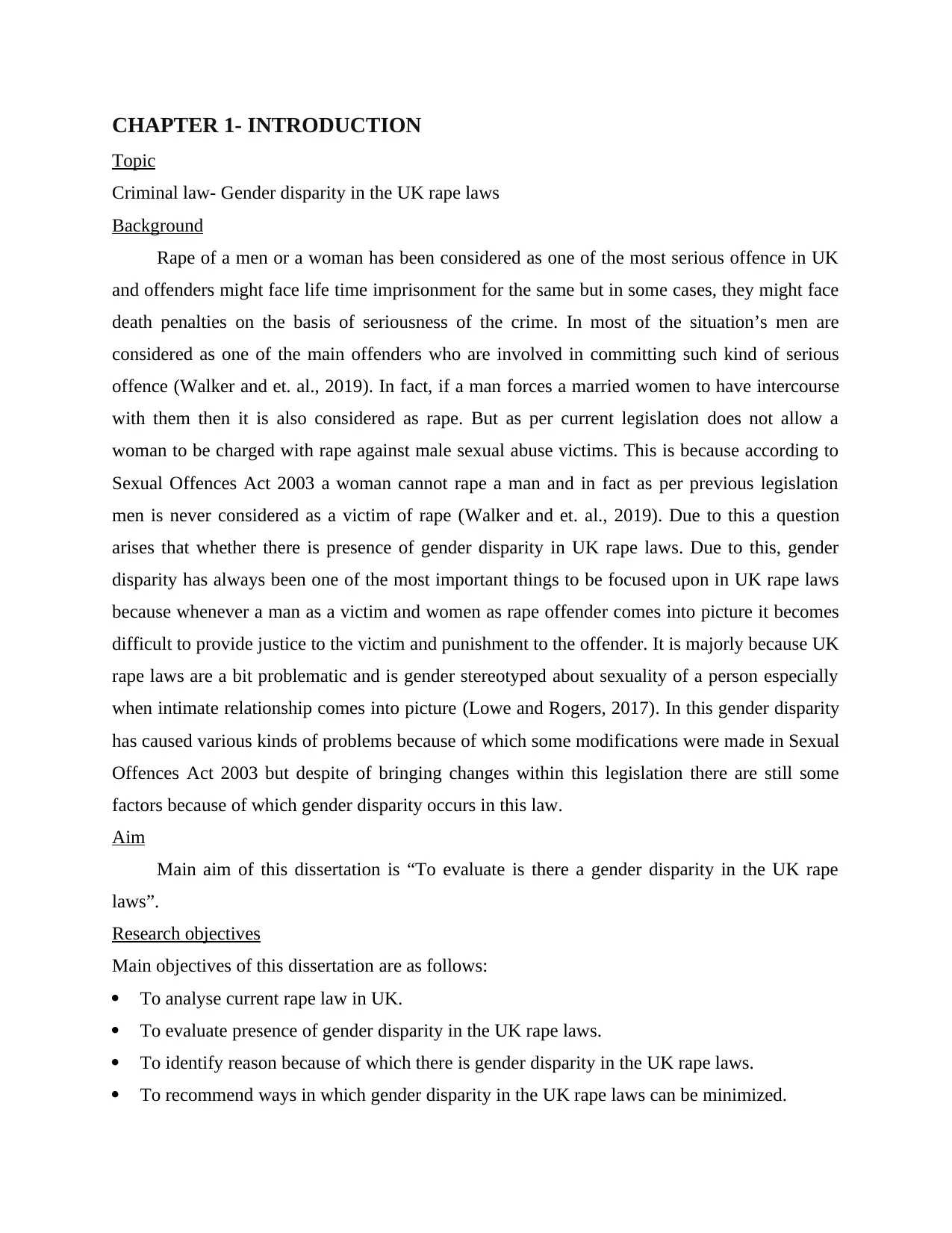
CHAPTER 1- INTRODUCTION
Topic
Criminal law- Gender disparity in the UK rape laws
Background
Rape of a men or a woman has been considered as one of the most serious offence in UK
and offenders might face life time imprisonment for the same but in some cases, they might face
death penalties on the basis of seriousness of the crime. In most of the situation’s men are
considered as one of the main offenders who are involved in committing such kind of serious
offence (Walker and et. al., 2019). In fact, if a man forces a married women to have intercourse
with them then it is also considered as rape. But as per current legislation does not allow a
woman to be charged with rape against male sexual abuse victims. This is because according to
Sexual Offences Act 2003 a woman cannot rape a man and in fact as per previous legislation
men is never considered as a victim of rape (Walker and et. al., 2019). Due to this a question
arises that whether there is presence of gender disparity in UK rape laws. Due to this, gender
disparity has always been one of the most important things to be focused upon in UK rape laws
because whenever a man as a victim and women as rape offender comes into picture it becomes
difficult to provide justice to the victim and punishment to the offender. It is majorly because UK
rape laws are a bit problematic and is gender stereotyped about sexuality of a person especially
when intimate relationship comes into picture (Lowe and Rogers, 2017). In this gender disparity
has caused various kinds of problems because of which some modifications were made in Sexual
Offences Act 2003 but despite of bringing changes within this legislation there are still some
factors because of which gender disparity occurs in this law.
Aim
Main aim of this dissertation is “To evaluate is there a gender disparity in the UK rape
laws”.
Research objectives
Main objectives of this dissertation are as follows:
To analyse current rape law in UK.
To evaluate presence of gender disparity in the UK rape laws.
To identify reason because of which there is gender disparity in the UK rape laws.
To recommend ways in which gender disparity in the UK rape laws can be minimized.
Topic
Criminal law- Gender disparity in the UK rape laws
Background
Rape of a men or a woman has been considered as one of the most serious offence in UK
and offenders might face life time imprisonment for the same but in some cases, they might face
death penalties on the basis of seriousness of the crime. In most of the situation’s men are
considered as one of the main offenders who are involved in committing such kind of serious
offence (Walker and et. al., 2019). In fact, if a man forces a married women to have intercourse
with them then it is also considered as rape. But as per current legislation does not allow a
woman to be charged with rape against male sexual abuse victims. This is because according to
Sexual Offences Act 2003 a woman cannot rape a man and in fact as per previous legislation
men is never considered as a victim of rape (Walker and et. al., 2019). Due to this a question
arises that whether there is presence of gender disparity in UK rape laws. Due to this, gender
disparity has always been one of the most important things to be focused upon in UK rape laws
because whenever a man as a victim and women as rape offender comes into picture it becomes
difficult to provide justice to the victim and punishment to the offender. It is majorly because UK
rape laws are a bit problematic and is gender stereotyped about sexuality of a person especially
when intimate relationship comes into picture (Lowe and Rogers, 2017). In this gender disparity
has caused various kinds of problems because of which some modifications were made in Sexual
Offences Act 2003 but despite of bringing changes within this legislation there are still some
factors because of which gender disparity occurs in this law.
Aim
Main aim of this dissertation is “To evaluate is there a gender disparity in the UK rape
laws”.
Research objectives
Main objectives of this dissertation are as follows:
To analyse current rape law in UK.
To evaluate presence of gender disparity in the UK rape laws.
To identify reason because of which there is gender disparity in the UK rape laws.
To recommend ways in which gender disparity in the UK rape laws can be minimized.
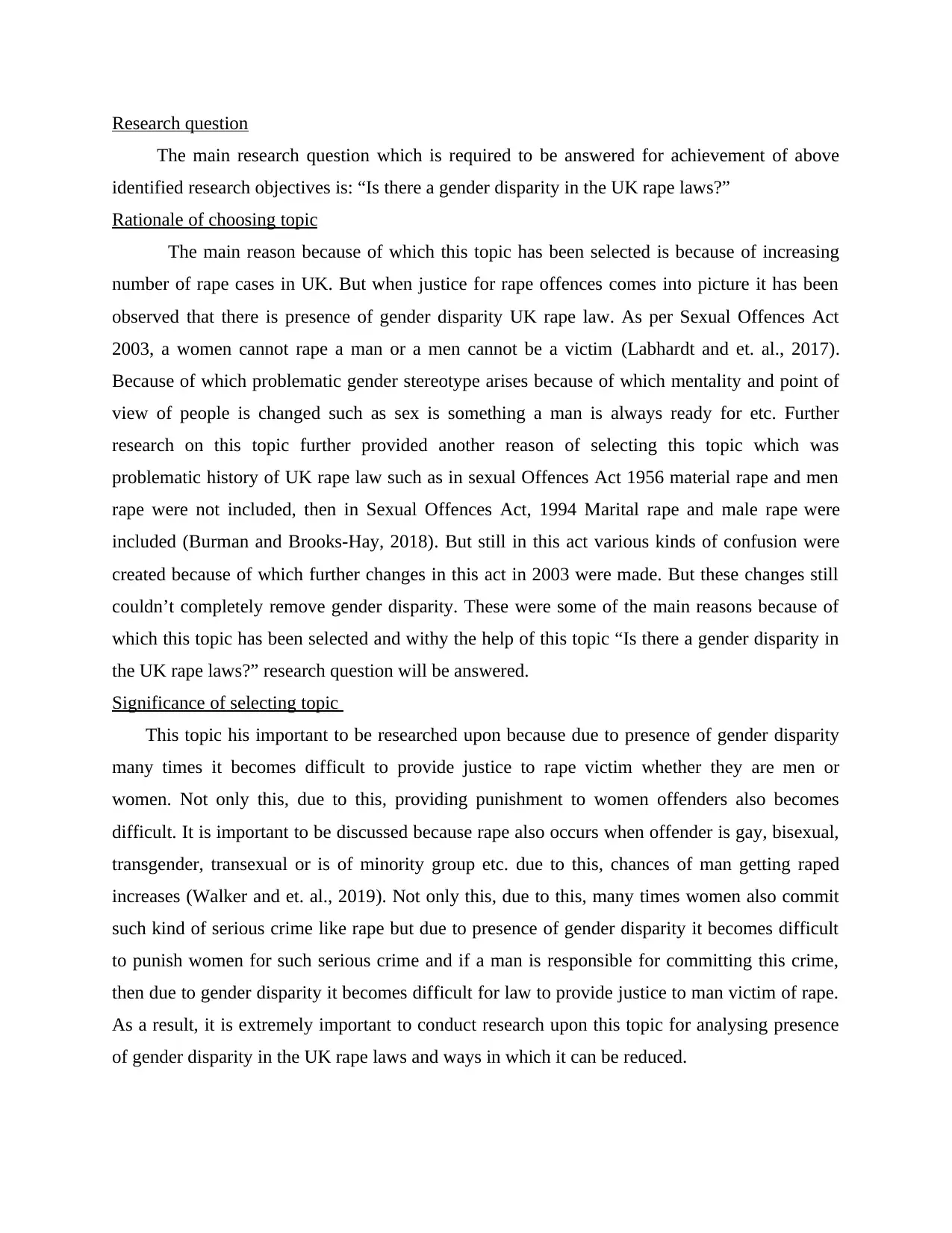
Research question
The main research question which is required to be answered for achievement of above
identified research objectives is: “Is there a gender disparity in the UK rape laws?”
Rationale of choosing topic
The main reason because of which this topic has been selected is because of increasing
number of rape cases in UK. But when justice for rape offences comes into picture it has been
observed that there is presence of gender disparity UK rape law. As per Sexual Offences Act
2003, a women cannot rape a man or a men cannot be a victim (Labhardt and et. al., 2017).
Because of which problematic gender stereotype arises because of which mentality and point of
view of people is changed such as sex is something a man is always ready for etc. Further
research on this topic further provided another reason of selecting this topic which was
problematic history of UK rape law such as in sexual Offences Act 1956 material rape and men
rape were not included, then in Sexual Offences Act, 1994 Marital rape and male rape were
included (Burman and Brooks-Hay, 2018). But still in this act various kinds of confusion were
created because of which further changes in this act in 2003 were made. But these changes still
couldn’t completely remove gender disparity. These were some of the main reasons because of
which this topic has been selected and withy the help of this topic “Is there a gender disparity in
the UK rape laws?” research question will be answered.
Significance of selecting topic
This topic his important to be researched upon because due to presence of gender disparity
many times it becomes difficult to provide justice to rape victim whether they are men or
women. Not only this, due to this, providing punishment to women offenders also becomes
difficult. It is important to be discussed because rape also occurs when offender is gay, bisexual,
transgender, transexual or is of minority group etc. due to this, chances of man getting raped
increases (Walker and et. al., 2019). Not only this, due to this, many times women also commit
such kind of serious crime like rape but due to presence of gender disparity it becomes difficult
to punish women for such serious crime and if a man is responsible for committing this crime,
then due to gender disparity it becomes difficult for law to provide justice to man victim of rape.
As a result, it is extremely important to conduct research upon this topic for analysing presence
of gender disparity in the UK rape laws and ways in which it can be reduced.
The main research question which is required to be answered for achievement of above
identified research objectives is: “Is there a gender disparity in the UK rape laws?”
Rationale of choosing topic
The main reason because of which this topic has been selected is because of increasing
number of rape cases in UK. But when justice for rape offences comes into picture it has been
observed that there is presence of gender disparity UK rape law. As per Sexual Offences Act
2003, a women cannot rape a man or a men cannot be a victim (Labhardt and et. al., 2017).
Because of which problematic gender stereotype arises because of which mentality and point of
view of people is changed such as sex is something a man is always ready for etc. Further
research on this topic further provided another reason of selecting this topic which was
problematic history of UK rape law such as in sexual Offences Act 1956 material rape and men
rape were not included, then in Sexual Offences Act, 1994 Marital rape and male rape were
included (Burman and Brooks-Hay, 2018). But still in this act various kinds of confusion were
created because of which further changes in this act in 2003 were made. But these changes still
couldn’t completely remove gender disparity. These were some of the main reasons because of
which this topic has been selected and withy the help of this topic “Is there a gender disparity in
the UK rape laws?” research question will be answered.
Significance of selecting topic
This topic his important to be researched upon because due to presence of gender disparity
many times it becomes difficult to provide justice to rape victim whether they are men or
women. Not only this, due to this, providing punishment to women offenders also becomes
difficult. It is important to be discussed because rape also occurs when offender is gay, bisexual,
transgender, transexual or is of minority group etc. due to this, chances of man getting raped
increases (Walker and et. al., 2019). Not only this, due to this, many times women also commit
such kind of serious crime like rape but due to presence of gender disparity it becomes difficult
to punish women for such serious crime and if a man is responsible for committing this crime,
then due to gender disparity it becomes difficult for law to provide justice to man victim of rape.
As a result, it is extremely important to conduct research upon this topic for analysing presence
of gender disparity in the UK rape laws and ways in which it can be reduced.
Secure Best Marks with AI Grader
Need help grading? Try our AI Grader for instant feedback on your assignments.
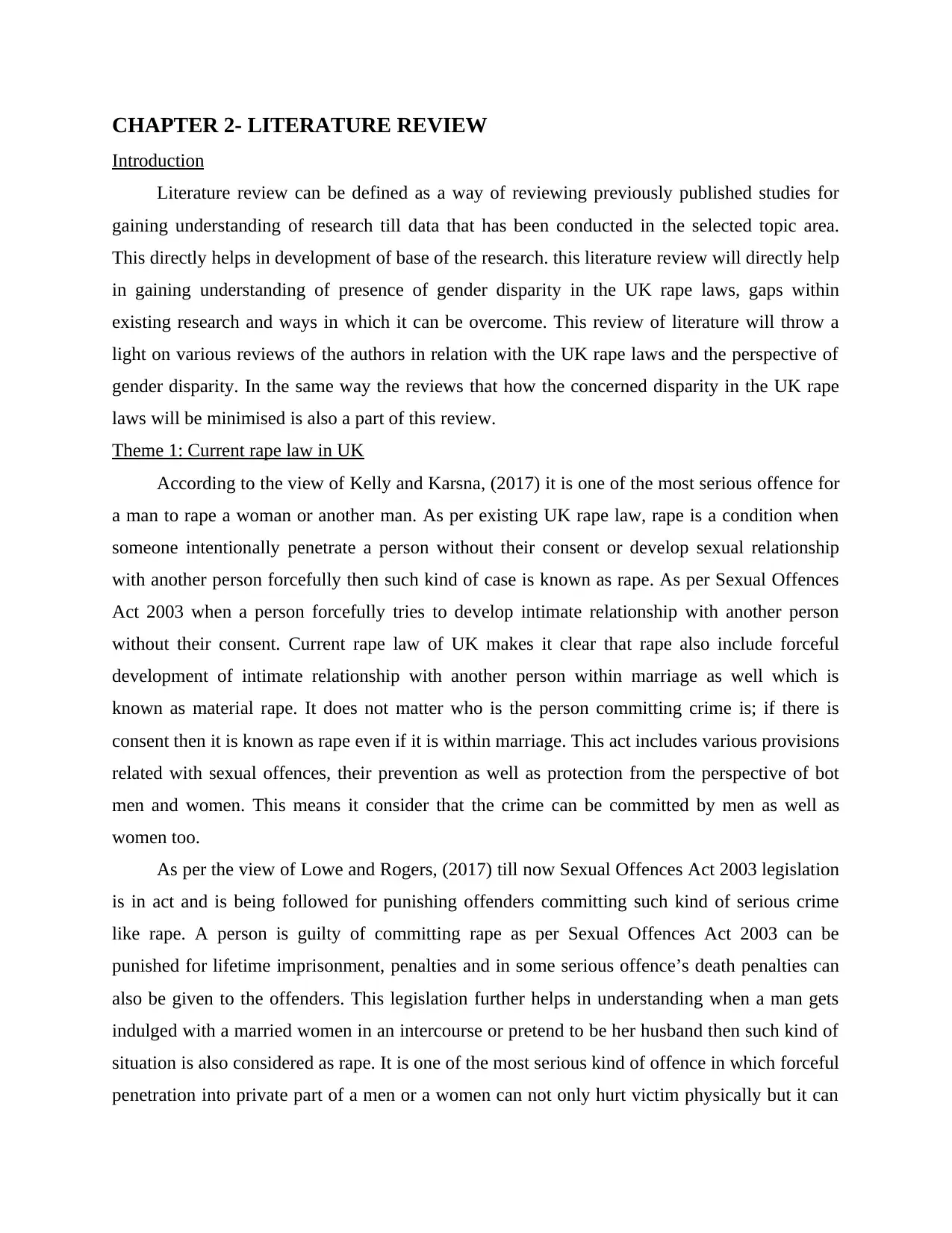
CHAPTER 2- LITERATURE REVIEW
Introduction
Literature review can be defined as a way of reviewing previously published studies for
gaining understanding of research till data that has been conducted in the selected topic area.
This directly helps in development of base of the research. this literature review will directly help
in gaining understanding of presence of gender disparity in the UK rape laws, gaps within
existing research and ways in which it can be overcome. This review of literature will throw a
light on various reviews of the authors in relation with the UK rape laws and the perspective of
gender disparity. In the same way the reviews that how the concerned disparity in the UK rape
laws will be minimised is also a part of this review.
Theme 1: Current rape law in UK
According to the view of Kelly and Karsna, (2017) it is one of the most serious offence for
a man to rape a woman or another man. As per existing UK rape law, rape is a condition when
someone intentionally penetrate a person without their consent or develop sexual relationship
with another person forcefully then such kind of case is known as rape. As per Sexual Offences
Act 2003 when a person forcefully tries to develop intimate relationship with another person
without their consent. Current rape law of UK makes it clear that rape also include forceful
development of intimate relationship with another person within marriage as well which is
known as material rape. It does not matter who is the person committing crime is; if there is
consent then it is known as rape even if it is within marriage. This act includes various provisions
related with sexual offences, their prevention as well as protection from the perspective of bot
men and women. This means it consider that the crime can be committed by men as well as
women too.
As per the view of Lowe and Rogers, (2017) till now Sexual Offences Act 2003 legislation
is in act and is being followed for punishing offenders committing such kind of serious crime
like rape. A person is guilty of committing rape as per Sexual Offences Act 2003 can be
punished for lifetime imprisonment, penalties and in some serious offence’s death penalties can
also be given to the offenders. This legislation further helps in understanding when a man gets
indulged with a married women in an intercourse or pretend to be her husband then such kind of
situation is also considered as rape. It is one of the most serious kind of offence in which forceful
penetration into private part of a men or a women can not only hurt victim physically but it can
Introduction
Literature review can be defined as a way of reviewing previously published studies for
gaining understanding of research till data that has been conducted in the selected topic area.
This directly helps in development of base of the research. this literature review will directly help
in gaining understanding of presence of gender disparity in the UK rape laws, gaps within
existing research and ways in which it can be overcome. This review of literature will throw a
light on various reviews of the authors in relation with the UK rape laws and the perspective of
gender disparity. In the same way the reviews that how the concerned disparity in the UK rape
laws will be minimised is also a part of this review.
Theme 1: Current rape law in UK
According to the view of Kelly and Karsna, (2017) it is one of the most serious offence for
a man to rape a woman or another man. As per existing UK rape law, rape is a condition when
someone intentionally penetrate a person without their consent or develop sexual relationship
with another person forcefully then such kind of case is known as rape. As per Sexual Offences
Act 2003 when a person forcefully tries to develop intimate relationship with another person
without their consent. Current rape law of UK makes it clear that rape also include forceful
development of intimate relationship with another person within marriage as well which is
known as material rape. It does not matter who is the person committing crime is; if there is
consent then it is known as rape even if it is within marriage. This act includes various provisions
related with sexual offences, their prevention as well as protection from the perspective of bot
men and women. This means it consider that the crime can be committed by men as well as
women too.
As per the view of Lowe and Rogers, (2017) till now Sexual Offences Act 2003 legislation
is in act and is being followed for punishing offenders committing such kind of serious crime
like rape. A person is guilty of committing rape as per Sexual Offences Act 2003 can be
punished for lifetime imprisonment, penalties and in some serious offence’s death penalties can
also be given to the offenders. This legislation further helps in understanding when a man gets
indulged with a married women in an intercourse or pretend to be her husband then such kind of
situation is also considered as rape. It is one of the most serious kind of offence in which forceful
penetration into private part of a men or a women can not only hurt victim physically but it can
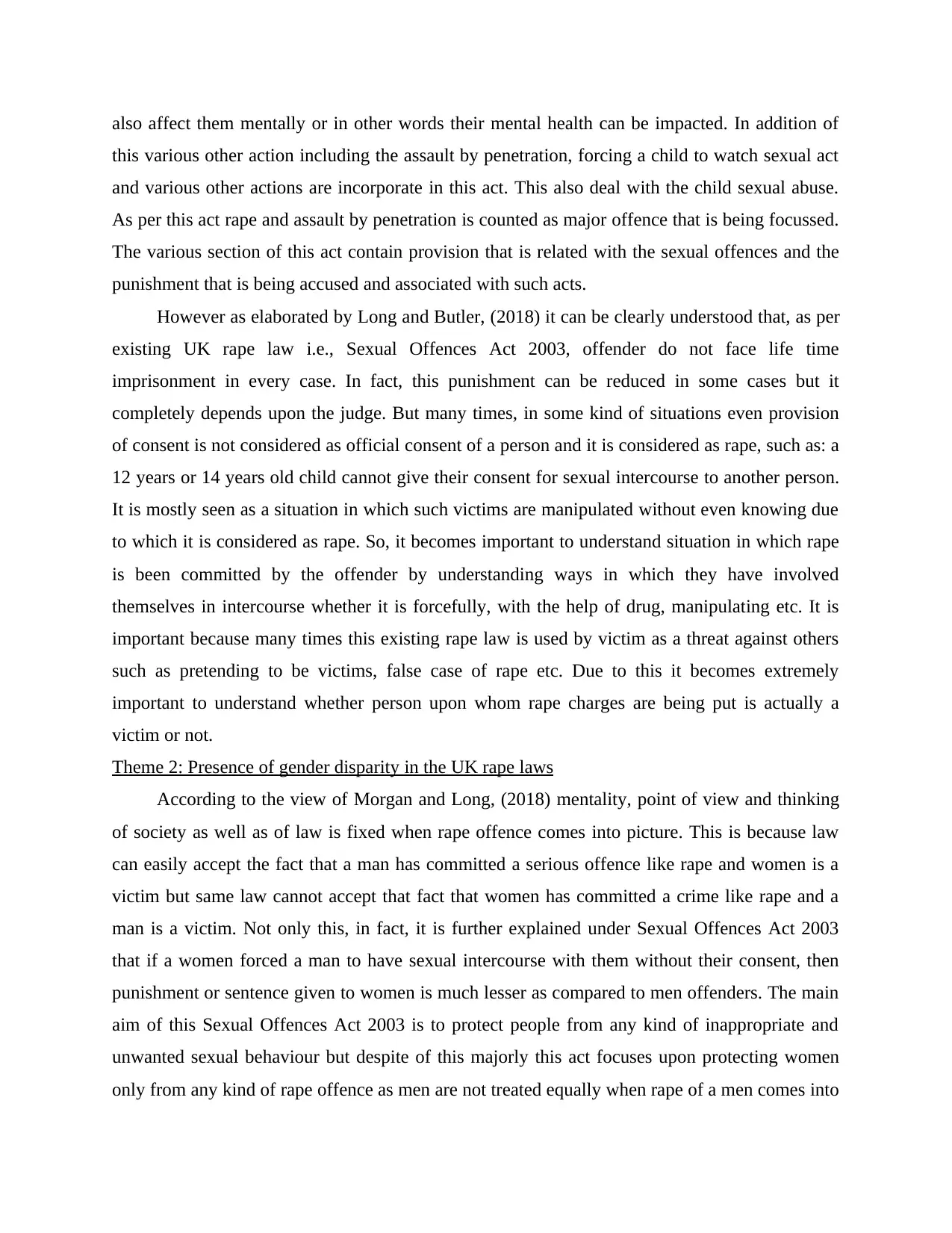
also affect them mentally or in other words their mental health can be impacted. In addition of
this various other action including the assault by penetration, forcing a child to watch sexual act
and various other actions are incorporate in this act. This also deal with the child sexual abuse.
As per this act rape and assault by penetration is counted as major offence that is being focussed.
The various section of this act contain provision that is related with the sexual offences and the
punishment that is being accused and associated with such acts.
However as elaborated by Long and Butler, (2018) it can be clearly understood that, as per
existing UK rape law i.e., Sexual Offences Act 2003, offender do not face life time
imprisonment in every case. In fact, this punishment can be reduced in some cases but it
completely depends upon the judge. But many times, in some kind of situations even provision
of consent is not considered as official consent of a person and it is considered as rape, such as: a
12 years or 14 years old child cannot give their consent for sexual intercourse to another person.
It is mostly seen as a situation in which such victims are manipulated without even knowing due
to which it is considered as rape. So, it becomes important to understand situation in which rape
is been committed by the offender by understanding ways in which they have involved
themselves in intercourse whether it is forcefully, with the help of drug, manipulating etc. It is
important because many times this existing rape law is used by victim as a threat against others
such as pretending to be victims, false case of rape etc. Due to this it becomes extremely
important to understand whether person upon whom rape charges are being put is actually a
victim or not.
Theme 2: Presence of gender disparity in the UK rape laws
According to the view of Morgan and Long, (2018) mentality, point of view and thinking
of society as well as of law is fixed when rape offence comes into picture. This is because law
can easily accept the fact that a man has committed a serious offence like rape and women is a
victim but same law cannot accept that fact that women has committed a crime like rape and a
man is a victim. Not only this, in fact, it is further explained under Sexual Offences Act 2003
that if a women forced a man to have sexual intercourse with them without their consent, then
punishment or sentence given to women is much lesser as compared to men offenders. The main
aim of this Sexual Offences Act 2003 is to protect people from any kind of inappropriate and
unwanted sexual behaviour but despite of this majorly this act focuses upon protecting women
only from any kind of rape offence as men are not treated equally when rape of a men comes into
this various other action including the assault by penetration, forcing a child to watch sexual act
and various other actions are incorporate in this act. This also deal with the child sexual abuse.
As per this act rape and assault by penetration is counted as major offence that is being focussed.
The various section of this act contain provision that is related with the sexual offences and the
punishment that is being accused and associated with such acts.
However as elaborated by Long and Butler, (2018) it can be clearly understood that, as per
existing UK rape law i.e., Sexual Offences Act 2003, offender do not face life time
imprisonment in every case. In fact, this punishment can be reduced in some cases but it
completely depends upon the judge. But many times, in some kind of situations even provision
of consent is not considered as official consent of a person and it is considered as rape, such as: a
12 years or 14 years old child cannot give their consent for sexual intercourse to another person.
It is mostly seen as a situation in which such victims are manipulated without even knowing due
to which it is considered as rape. So, it becomes important to understand situation in which rape
is been committed by the offender by understanding ways in which they have involved
themselves in intercourse whether it is forcefully, with the help of drug, manipulating etc. It is
important because many times this existing rape law is used by victim as a threat against others
such as pretending to be victims, false case of rape etc. Due to this it becomes extremely
important to understand whether person upon whom rape charges are being put is actually a
victim or not.
Theme 2: Presence of gender disparity in the UK rape laws
According to the view of Morgan and Long, (2018) mentality, point of view and thinking
of society as well as of law is fixed when rape offence comes into picture. This is because law
can easily accept the fact that a man has committed a serious offence like rape and women is a
victim but same law cannot accept that fact that women has committed a crime like rape and a
man is a victim. Not only this, in fact, it is further explained under Sexual Offences Act 2003
that if a women forced a man to have sexual intercourse with them without their consent, then
punishment or sentence given to women is much lesser as compared to men offenders. The main
aim of this Sexual Offences Act 2003 is to protect people from any kind of inappropriate and
unwanted sexual behaviour but despite of this majorly this act focuses upon protecting women
only from any kind of rape offence as men are not treated equally when rape of a men comes into
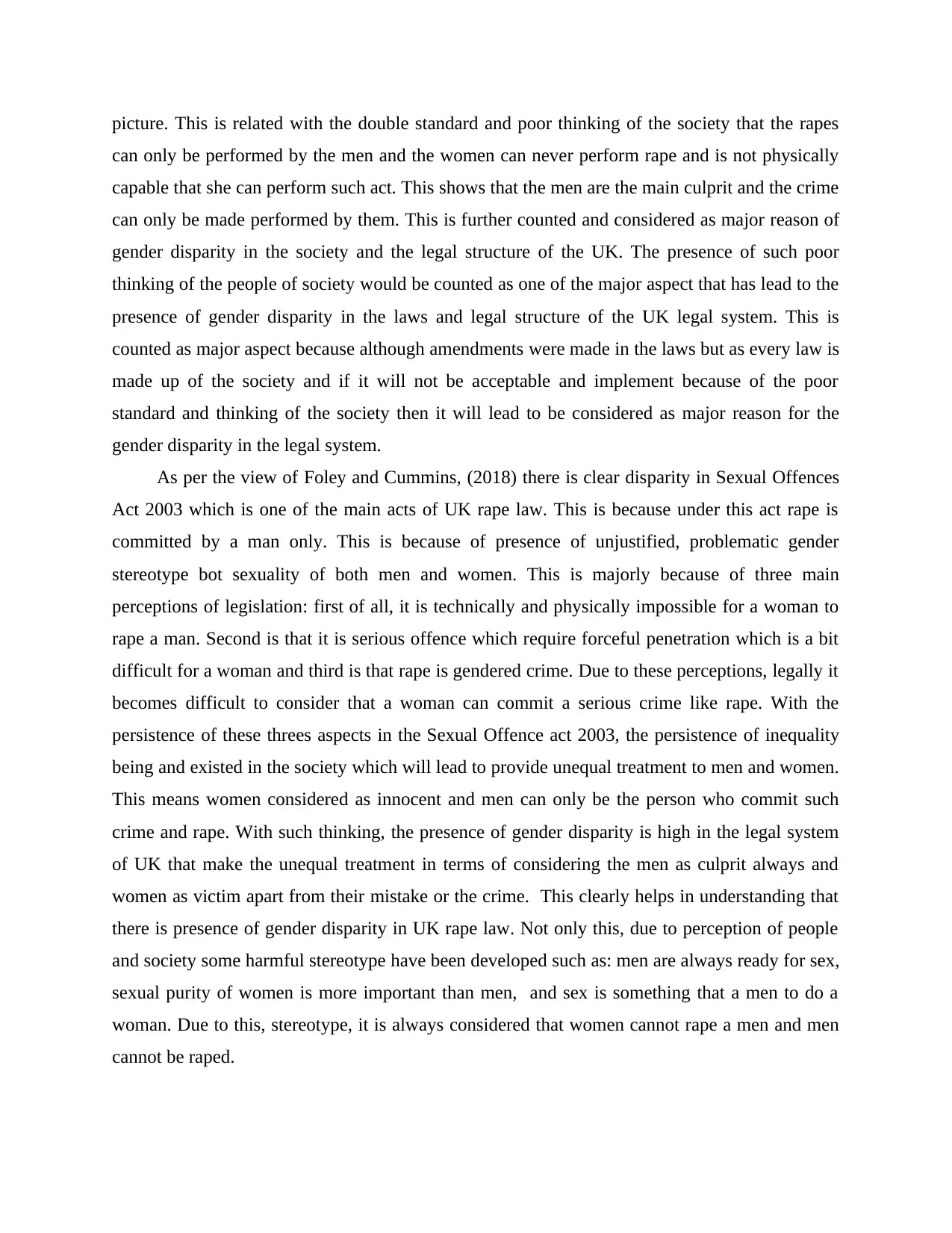
picture. This is related with the double standard and poor thinking of the society that the rapes
can only be performed by the men and the women can never perform rape and is not physically
capable that she can perform such act. This shows that the men are the main culprit and the crime
can only be made performed by them. This is further counted and considered as major reason of
gender disparity in the society and the legal structure of the UK. The presence of such poor
thinking of the people of society would be counted as one of the major aspect that has lead to the
presence of gender disparity in the laws and legal structure of the UK legal system. This is
counted as major aspect because although amendments were made in the laws but as every law is
made up of the society and if it will not be acceptable and implement because of the poor
standard and thinking of the society then it will lead to be considered as major reason for the
gender disparity in the legal system.
As per the view of Foley and Cummins, (2018) there is clear disparity in Sexual Offences
Act 2003 which is one of the main acts of UK rape law. This is because under this act rape is
committed by a man only. This is because of presence of unjustified, problematic gender
stereotype bot sexuality of both men and women. This is majorly because of three main
perceptions of legislation: first of all, it is technically and physically impossible for a woman to
rape a man. Second is that it is serious offence which require forceful penetration which is a bit
difficult for a woman and third is that rape is gendered crime. Due to these perceptions, legally it
becomes difficult to consider that a woman can commit a serious crime like rape. With the
persistence of these threes aspects in the Sexual Offence act 2003, the persistence of inequality
being and existed in the society which will lead to provide unequal treatment to men and women.
This means women considered as innocent and men can only be the person who commit such
crime and rape. With such thinking, the presence of gender disparity is high in the legal system
of UK that make the unequal treatment in terms of considering the men as culprit always and
women as victim apart from their mistake or the crime. This clearly helps in understanding that
there is presence of gender disparity in UK rape law. Not only this, due to perception of people
and society some harmful stereotype have been developed such as: men are always ready for sex,
sexual purity of women is more important than men, and sex is something that a men to do a
woman. Due to this, stereotype, it is always considered that women cannot rape a men and men
cannot be raped.
can only be performed by the men and the women can never perform rape and is not physically
capable that she can perform such act. This shows that the men are the main culprit and the crime
can only be made performed by them. This is further counted and considered as major reason of
gender disparity in the society and the legal structure of the UK. The presence of such poor
thinking of the people of society would be counted as one of the major aspect that has lead to the
presence of gender disparity in the laws and legal structure of the UK legal system. This is
counted as major aspect because although amendments were made in the laws but as every law is
made up of the society and if it will not be acceptable and implement because of the poor
standard and thinking of the society then it will lead to be considered as major reason for the
gender disparity in the legal system.
As per the view of Foley and Cummins, (2018) there is clear disparity in Sexual Offences
Act 2003 which is one of the main acts of UK rape law. This is because under this act rape is
committed by a man only. This is because of presence of unjustified, problematic gender
stereotype bot sexuality of both men and women. This is majorly because of three main
perceptions of legislation: first of all, it is technically and physically impossible for a woman to
rape a man. Second is that it is serious offence which require forceful penetration which is a bit
difficult for a woman and third is that rape is gendered crime. Due to these perceptions, legally it
becomes difficult to consider that a woman can commit a serious crime like rape. With the
persistence of these threes aspects in the Sexual Offence act 2003, the persistence of inequality
being and existed in the society which will lead to provide unequal treatment to men and women.
This means women considered as innocent and men can only be the person who commit such
crime and rape. With such thinking, the presence of gender disparity is high in the legal system
of UK that make the unequal treatment in terms of considering the men as culprit always and
women as victim apart from their mistake or the crime. This clearly helps in understanding that
there is presence of gender disparity in UK rape law. Not only this, due to perception of people
and society some harmful stereotype have been developed such as: men are always ready for sex,
sexual purity of women is more important than men, and sex is something that a men to do a
woman. Due to this, stereotype, it is always considered that women cannot rape a men and men
cannot be raped.
Paraphrase This Document
Need a fresh take? Get an instant paraphrase of this document with our AI Paraphraser
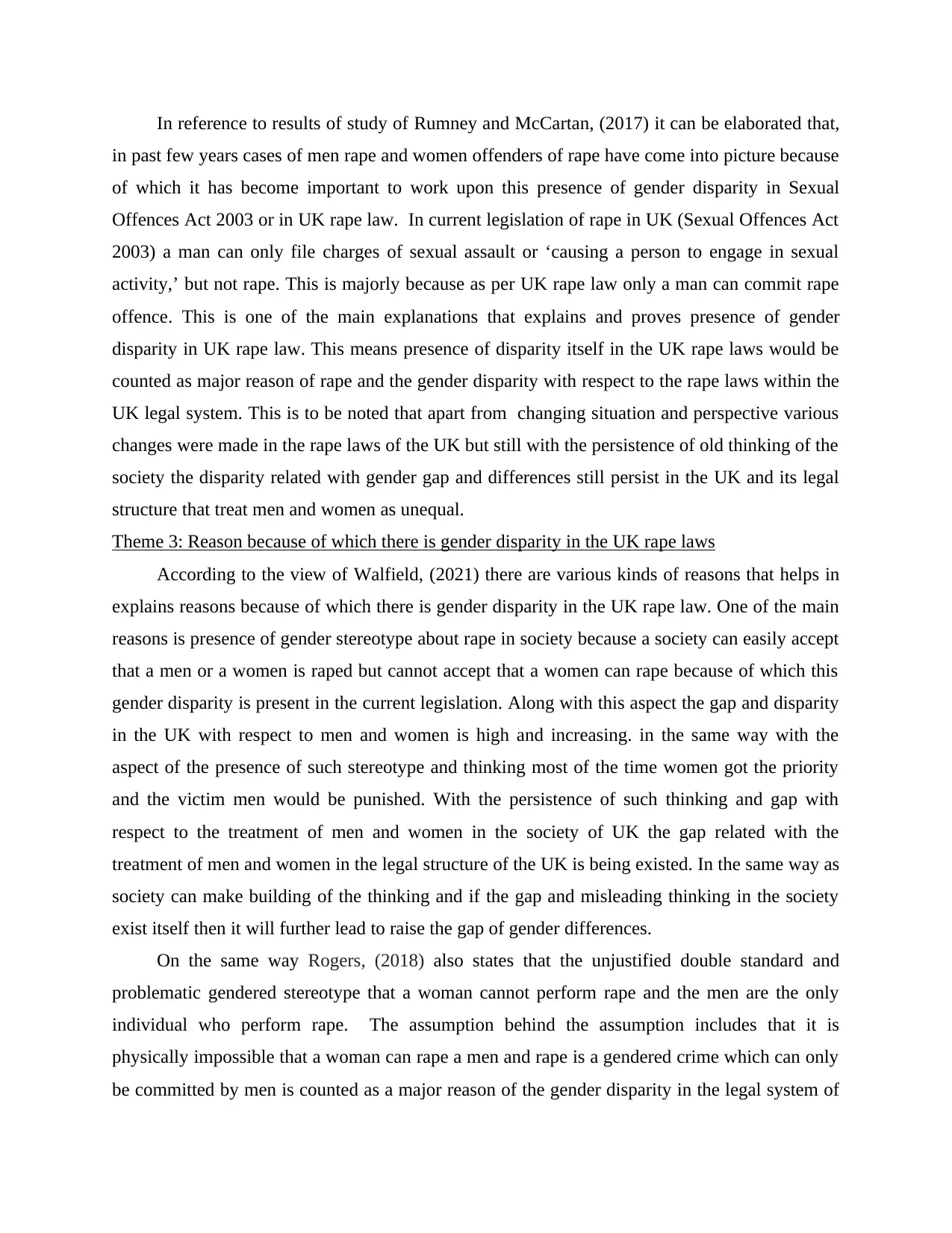
In reference to results of study of Rumney and McCartan, (2017) it can be elaborated that,
in past few years cases of men rape and women offenders of rape have come into picture because
of which it has become important to work upon this presence of gender disparity in Sexual
Offences Act 2003 or in UK rape law. In current legislation of rape in UK (Sexual Offences Act
2003) a man can only file charges of sexual assault or ‘causing a person to engage in sexual
activity,’ but not rape. This is majorly because as per UK rape law only a man can commit rape
offence. This is one of the main explanations that explains and proves presence of gender
disparity in UK rape law. This means presence of disparity itself in the UK rape laws would be
counted as major reason of rape and the gender disparity with respect to the rape laws within the
UK legal system. This is to be noted that apart from changing situation and perspective various
changes were made in the rape laws of the UK but still with the persistence of old thinking of the
society the disparity related with gender gap and differences still persist in the UK and its legal
structure that treat men and women as unequal.
Theme 3: Reason because of which there is gender disparity in the UK rape laws
According to the view of Walfield, (2021) there are various kinds of reasons that helps in
explains reasons because of which there is gender disparity in the UK rape law. One of the main
reasons is presence of gender stereotype about rape in society because a society can easily accept
that a men or a women is raped but cannot accept that a women can rape because of which this
gender disparity is present in the current legislation. Along with this aspect the gap and disparity
in the UK with respect to men and women is high and increasing. in the same way with the
aspect of the presence of such stereotype and thinking most of the time women got the priority
and the victim men would be punished. With the persistence of such thinking and gap with
respect to the treatment of men and women in the society of UK the gap related with the
treatment of men and women in the legal structure of the UK is being existed. In the same way as
society can make building of the thinking and if the gap and misleading thinking in the society
exist itself then it will further lead to raise the gap of gender differences.
On the same way Rogers, (2018) also states that the unjustified double standard and
problematic gendered stereotype that a woman cannot perform rape and the men are the only
individual who perform rape. The assumption behind the assumption includes that it is
physically impossible that a woman can rape a men and rape is a gendered crime which can only
be committed by men is counted as a major reason of the gender disparity in the legal system of
in past few years cases of men rape and women offenders of rape have come into picture because
of which it has become important to work upon this presence of gender disparity in Sexual
Offences Act 2003 or in UK rape law. In current legislation of rape in UK (Sexual Offences Act
2003) a man can only file charges of sexual assault or ‘causing a person to engage in sexual
activity,’ but not rape. This is majorly because as per UK rape law only a man can commit rape
offence. This is one of the main explanations that explains and proves presence of gender
disparity in UK rape law. This means presence of disparity itself in the UK rape laws would be
counted as major reason of rape and the gender disparity with respect to the rape laws within the
UK legal system. This is to be noted that apart from changing situation and perspective various
changes were made in the rape laws of the UK but still with the persistence of old thinking of the
society the disparity related with gender gap and differences still persist in the UK and its legal
structure that treat men and women as unequal.
Theme 3: Reason because of which there is gender disparity in the UK rape laws
According to the view of Walfield, (2021) there are various kinds of reasons that helps in
explains reasons because of which there is gender disparity in the UK rape law. One of the main
reasons is presence of gender stereotype about rape in society because a society can easily accept
that a men or a women is raped but cannot accept that a women can rape because of which this
gender disparity is present in the current legislation. Along with this aspect the gap and disparity
in the UK with respect to men and women is high and increasing. in the same way with the
aspect of the presence of such stereotype and thinking most of the time women got the priority
and the victim men would be punished. With the persistence of such thinking and gap with
respect to the treatment of men and women in the society of UK the gap related with the
treatment of men and women in the legal structure of the UK is being existed. In the same way as
society can make building of the thinking and if the gap and misleading thinking in the society
exist itself then it will further lead to raise the gap of gender differences.
On the same way Rogers, (2018) also states that the unjustified double standard and
problematic gendered stereotype that a woman cannot perform rape and the men are the only
individual who perform rape. The assumption behind the assumption includes that it is
physically impossible that a woman can rape a men and rape is a gendered crime which can only
be committed by men is counted as a major reason of the gender disparity in the legal system of
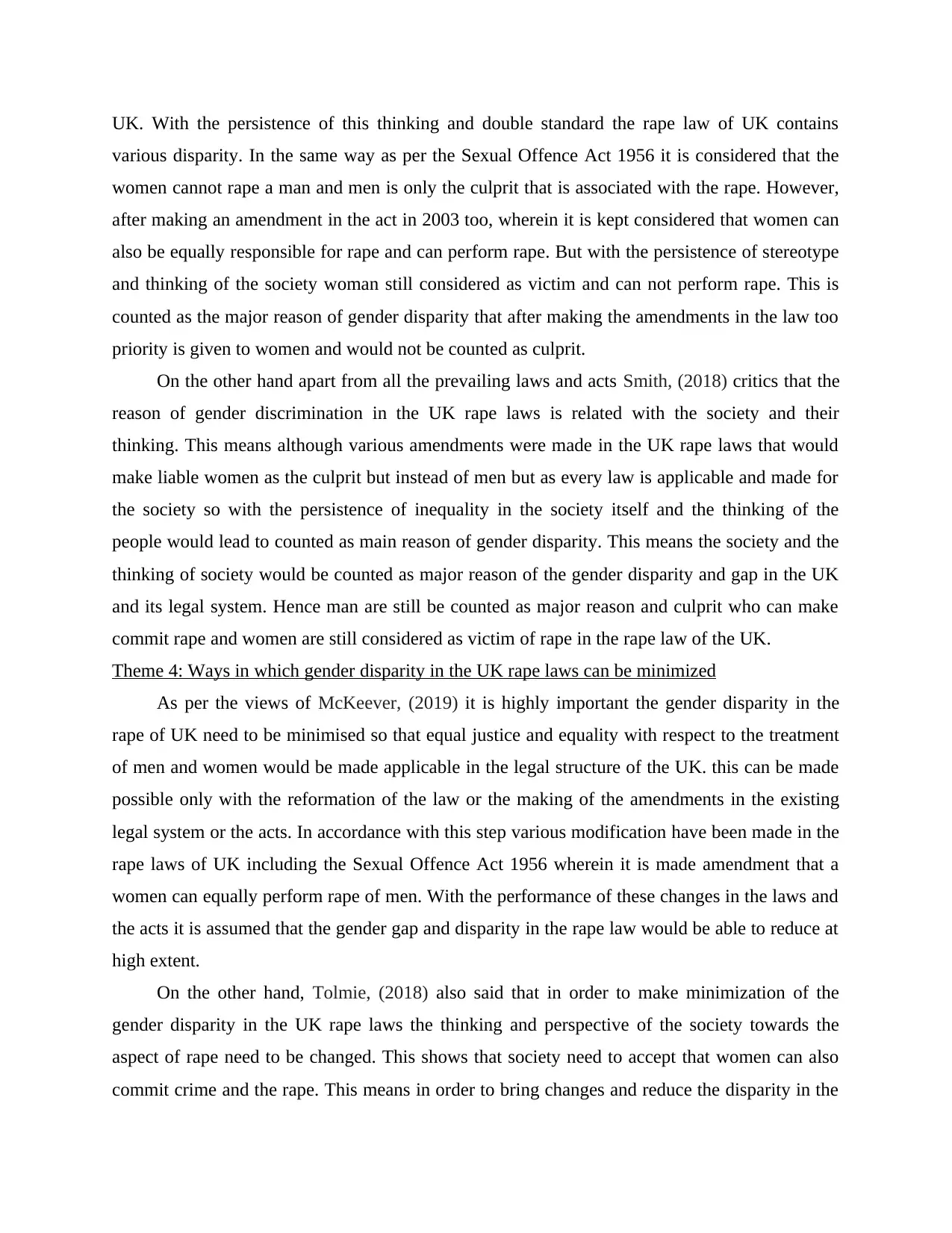
UK. With the persistence of this thinking and double standard the rape law of UK contains
various disparity. In the same way as per the Sexual Offence Act 1956 it is considered that the
women cannot rape a man and men is only the culprit that is associated with the rape. However,
after making an amendment in the act in 2003 too, wherein it is kept considered that women can
also be equally responsible for rape and can perform rape. But with the persistence of stereotype
and thinking of the society woman still considered as victim and can not perform rape. This is
counted as the major reason of gender disparity that after making the amendments in the law too
priority is given to women and would not be counted as culprit.
On the other hand apart from all the prevailing laws and acts Smith, (2018) critics that the
reason of gender discrimination in the UK rape laws is related with the society and their
thinking. This means although various amendments were made in the UK rape laws that would
make liable women as the culprit but instead of men but as every law is applicable and made for
the society so with the persistence of inequality in the society itself and the thinking of the
people would lead to counted as main reason of gender disparity. This means the society and the
thinking of society would be counted as major reason of the gender disparity and gap in the UK
and its legal system. Hence man are still be counted as major reason and culprit who can make
commit rape and women are still considered as victim of rape in the rape law of the UK.
Theme 4: Ways in which gender disparity in the UK rape laws can be minimized
As per the views of McKeever, (2019) it is highly important the gender disparity in the
rape of UK need to be minimised so that equal justice and equality with respect to the treatment
of men and women would be made applicable in the legal structure of the UK. this can be made
possible only with the reformation of the law or the making of the amendments in the existing
legal system or the acts. In accordance with this step various modification have been made in the
rape laws of UK including the Sexual Offence Act 1956 wherein it is made amendment that a
women can equally perform rape of men. With the performance of these changes in the laws and
the acts it is assumed that the gender gap and disparity in the rape law would be able to reduce at
high extent.
On the other hand, Tolmie, (2018) also said that in order to make minimization of the
gender disparity in the UK rape laws the thinking and perspective of the society towards the
aspect of rape need to be changed. This shows that society need to accept that women can also
commit crime and the rape. This means in order to bring changes and reduce the disparity in the
various disparity. In the same way as per the Sexual Offence Act 1956 it is considered that the
women cannot rape a man and men is only the culprit that is associated with the rape. However,
after making an amendment in the act in 2003 too, wherein it is kept considered that women can
also be equally responsible for rape and can perform rape. But with the persistence of stereotype
and thinking of the society woman still considered as victim and can not perform rape. This is
counted as the major reason of gender disparity that after making the amendments in the law too
priority is given to women and would not be counted as culprit.
On the other hand apart from all the prevailing laws and acts Smith, (2018) critics that the
reason of gender discrimination in the UK rape laws is related with the society and their
thinking. This means although various amendments were made in the UK rape laws that would
make liable women as the culprit but instead of men but as every law is applicable and made for
the society so with the persistence of inequality in the society itself and the thinking of the
people would lead to counted as main reason of gender disparity. This means the society and the
thinking of society would be counted as major reason of the gender disparity and gap in the UK
and its legal system. Hence man are still be counted as major reason and culprit who can make
commit rape and women are still considered as victim of rape in the rape law of the UK.
Theme 4: Ways in which gender disparity in the UK rape laws can be minimized
As per the views of McKeever, (2019) it is highly important the gender disparity in the
rape of UK need to be minimised so that equal justice and equality with respect to the treatment
of men and women would be made applicable in the legal structure of the UK. this can be made
possible only with the reformation of the law or the making of the amendments in the existing
legal system or the acts. In accordance with this step various modification have been made in the
rape laws of UK including the Sexual Offence Act 1956 wherein it is made amendment that a
women can equally perform rape of men. With the performance of these changes in the laws and
the acts it is assumed that the gender gap and disparity in the rape law would be able to reduce at
high extent.
On the other hand, Tolmie, (2018) also said that in order to make minimization of the
gender disparity in the UK rape laws the thinking and perspective of the society towards the
aspect of rape need to be changed. This shows that society need to accept that women can also
commit crime and the rape. This means in order to bring changes and reduce the disparity in the
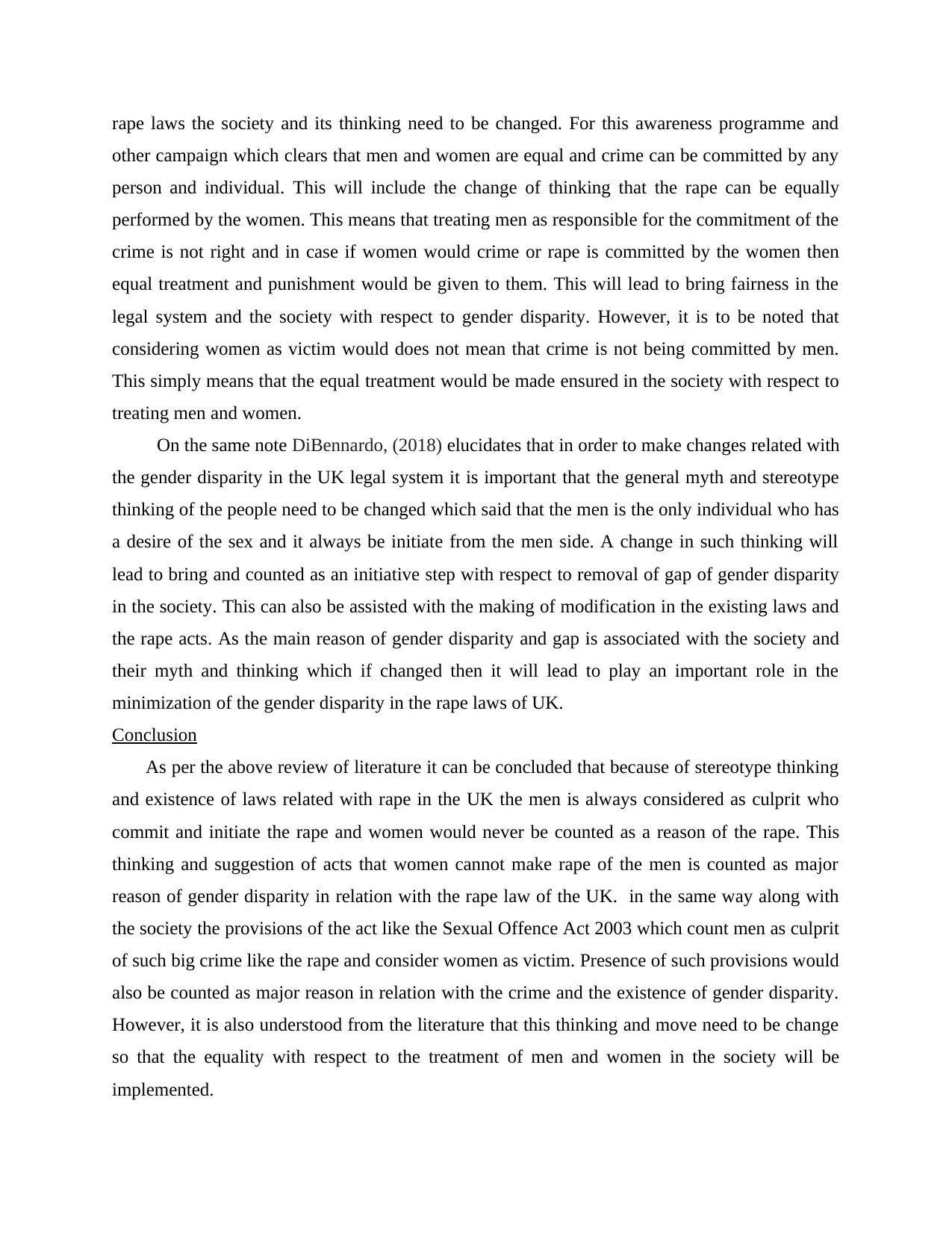
rape laws the society and its thinking need to be changed. For this awareness programme and
other campaign which clears that men and women are equal and crime can be committed by any
person and individual. This will include the change of thinking that the rape can be equally
performed by the women. This means that treating men as responsible for the commitment of the
crime is not right and in case if women would crime or rape is committed by the women then
equal treatment and punishment would be given to them. This will lead to bring fairness in the
legal system and the society with respect to gender disparity. However, it is to be noted that
considering women as victim would does not mean that crime is not being committed by men.
This simply means that the equal treatment would be made ensured in the society with respect to
treating men and women.
On the same note DiBennardo, (2018) elucidates that in order to make changes related with
the gender disparity in the UK legal system it is important that the general myth and stereotype
thinking of the people need to be changed which said that the men is the only individual who has
a desire of the sex and it always be initiate from the men side. A change in such thinking will
lead to bring and counted as an initiative step with respect to removal of gap of gender disparity
in the society. This can also be assisted with the making of modification in the existing laws and
the rape acts. As the main reason of gender disparity and gap is associated with the society and
their myth and thinking which if changed then it will lead to play an important role in the
minimization of the gender disparity in the rape laws of UK.
Conclusion
As per the above review of literature it can be concluded that because of stereotype thinking
and existence of laws related with rape in the UK the men is always considered as culprit who
commit and initiate the rape and women would never be counted as a reason of the rape. This
thinking and suggestion of acts that women cannot make rape of the men is counted as major
reason of gender disparity in relation with the rape law of the UK. in the same way along with
the society the provisions of the act like the Sexual Offence Act 2003 which count men as culprit
of such big crime like the rape and consider women as victim. Presence of such provisions would
also be counted as major reason in relation with the crime and the existence of gender disparity.
However, it is also understood from the literature that this thinking and move need to be change
so that the equality with respect to the treatment of men and women in the society will be
implemented.
other campaign which clears that men and women are equal and crime can be committed by any
person and individual. This will include the change of thinking that the rape can be equally
performed by the women. This means that treating men as responsible for the commitment of the
crime is not right and in case if women would crime or rape is committed by the women then
equal treatment and punishment would be given to them. This will lead to bring fairness in the
legal system and the society with respect to gender disparity. However, it is to be noted that
considering women as victim would does not mean that crime is not being committed by men.
This simply means that the equal treatment would be made ensured in the society with respect to
treating men and women.
On the same note DiBennardo, (2018) elucidates that in order to make changes related with
the gender disparity in the UK legal system it is important that the general myth and stereotype
thinking of the people need to be changed which said that the men is the only individual who has
a desire of the sex and it always be initiate from the men side. A change in such thinking will
lead to bring and counted as an initiative step with respect to removal of gap of gender disparity
in the society. This can also be assisted with the making of modification in the existing laws and
the rape acts. As the main reason of gender disparity and gap is associated with the society and
their myth and thinking which if changed then it will lead to play an important role in the
minimization of the gender disparity in the rape laws of UK.
Conclusion
As per the above review of literature it can be concluded that because of stereotype thinking
and existence of laws related with rape in the UK the men is always considered as culprit who
commit and initiate the rape and women would never be counted as a reason of the rape. This
thinking and suggestion of acts that women cannot make rape of the men is counted as major
reason of gender disparity in relation with the rape law of the UK. in the same way along with
the society the provisions of the act like the Sexual Offence Act 2003 which count men as culprit
of such big crime like the rape and consider women as victim. Presence of such provisions would
also be counted as major reason in relation with the crime and the existence of gender disparity.
However, it is also understood from the literature that this thinking and move need to be change
so that the equality with respect to the treatment of men and women in the society will be
implemented.
Secure Best Marks with AI Grader
Need help grading? Try our AI Grader for instant feedback on your assignments.
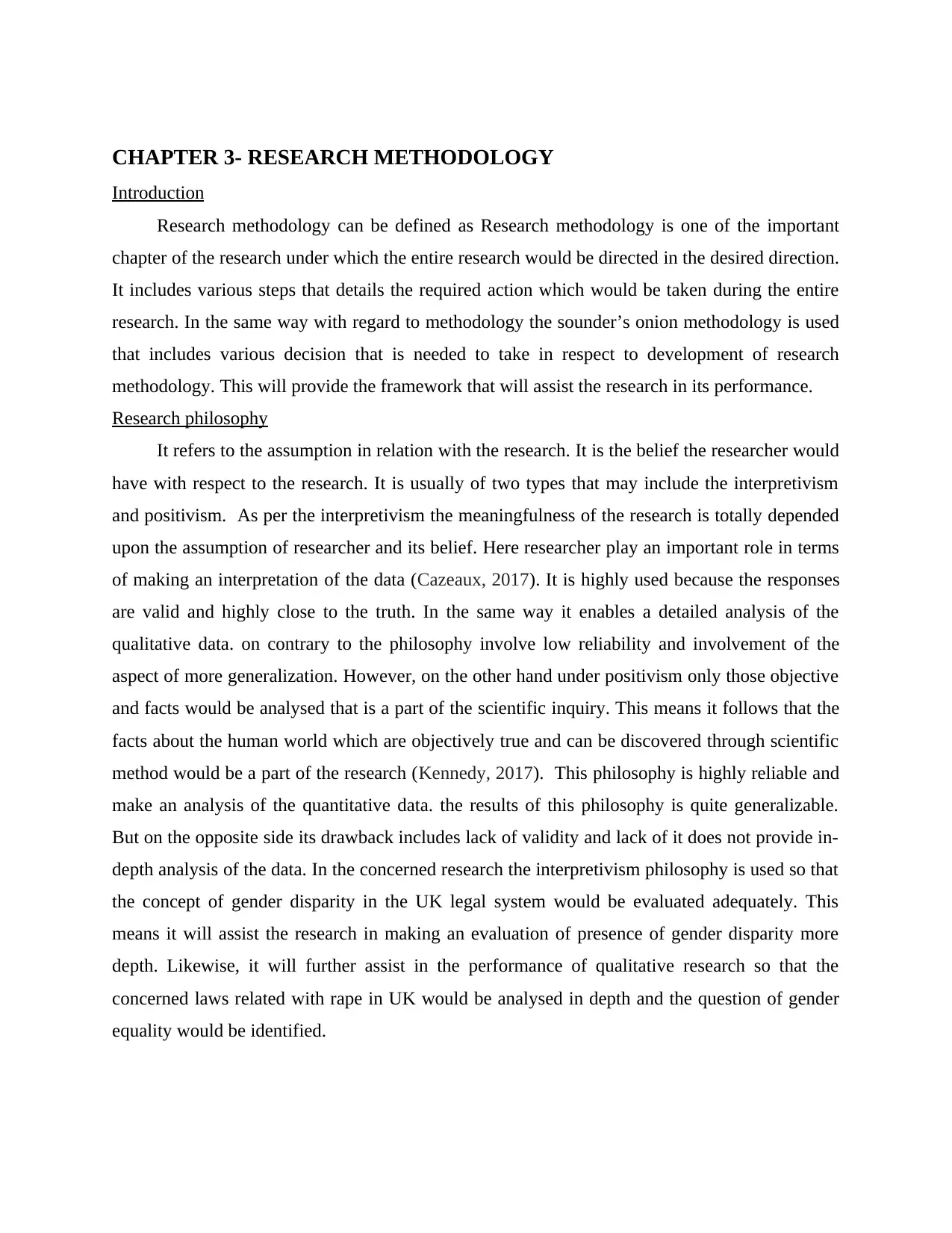
CHAPTER 3- RESEARCH METHODOLOGY
Introduction
Research methodology can be defined as Research methodology is one of the important
chapter of the research under which the entire research would be directed in the desired direction.
It includes various steps that details the required action which would be taken during the entire
research. In the same way with regard to methodology the sounder’s onion methodology is used
that includes various decision that is needed to take in respect to development of research
methodology. This will provide the framework that will assist the research in its performance.
Research philosophy
It refers to the assumption in relation with the research. It is the belief the researcher would
have with respect to the research. It is usually of two types that may include the interpretivism
and positivism. As per the interpretivism the meaningfulness of the research is totally depended
upon the assumption of researcher and its belief. Here researcher play an important role in terms
of making an interpretation of the data (Cazeaux, 2017). It is highly used because the responses
are valid and highly close to the truth. In the same way it enables a detailed analysis of the
qualitative data. on contrary to the philosophy involve low reliability and involvement of the
aspect of more generalization. However, on the other hand under positivism only those objective
and facts would be analysed that is a part of the scientific inquiry. This means it follows that the
facts about the human world which are objectively true and can be discovered through scientific
method would be a part of the research (Kennedy, 2017). This philosophy is highly reliable and
make an analysis of the quantitative data. the results of this philosophy is quite generalizable.
But on the opposite side its drawback includes lack of validity and lack of it does not provide in-
depth analysis of the data. In the concerned research the interpretivism philosophy is used so that
the concept of gender disparity in the UK legal system would be evaluated adequately. This
means it will assist the research in making an evaluation of presence of gender disparity more
depth. Likewise, it will further assist in the performance of qualitative research so that the
concerned laws related with rape in UK would be analysed in depth and the question of gender
equality would be identified.
Introduction
Research methodology can be defined as Research methodology is one of the important
chapter of the research under which the entire research would be directed in the desired direction.
It includes various steps that details the required action which would be taken during the entire
research. In the same way with regard to methodology the sounder’s onion methodology is used
that includes various decision that is needed to take in respect to development of research
methodology. This will provide the framework that will assist the research in its performance.
Research philosophy
It refers to the assumption in relation with the research. It is the belief the researcher would
have with respect to the research. It is usually of two types that may include the interpretivism
and positivism. As per the interpretivism the meaningfulness of the research is totally depended
upon the assumption of researcher and its belief. Here researcher play an important role in terms
of making an interpretation of the data (Cazeaux, 2017). It is highly used because the responses
are valid and highly close to the truth. In the same way it enables a detailed analysis of the
qualitative data. on contrary to the philosophy involve low reliability and involvement of the
aspect of more generalization. However, on the other hand under positivism only those objective
and facts would be analysed that is a part of the scientific inquiry. This means it follows that the
facts about the human world which are objectively true and can be discovered through scientific
method would be a part of the research (Kennedy, 2017). This philosophy is highly reliable and
make an analysis of the quantitative data. the results of this philosophy is quite generalizable.
But on the opposite side its drawback includes lack of validity and lack of it does not provide in-
depth analysis of the data. In the concerned research the interpretivism philosophy is used so that
the concept of gender disparity in the UK legal system would be evaluated adequately. This
means it will assist the research in making an evaluation of presence of gender disparity more
depth. Likewise, it will further assist in the performance of qualitative research so that the
concerned laws related with rape in UK would be analysed in depth and the question of gender
equality would be identified.
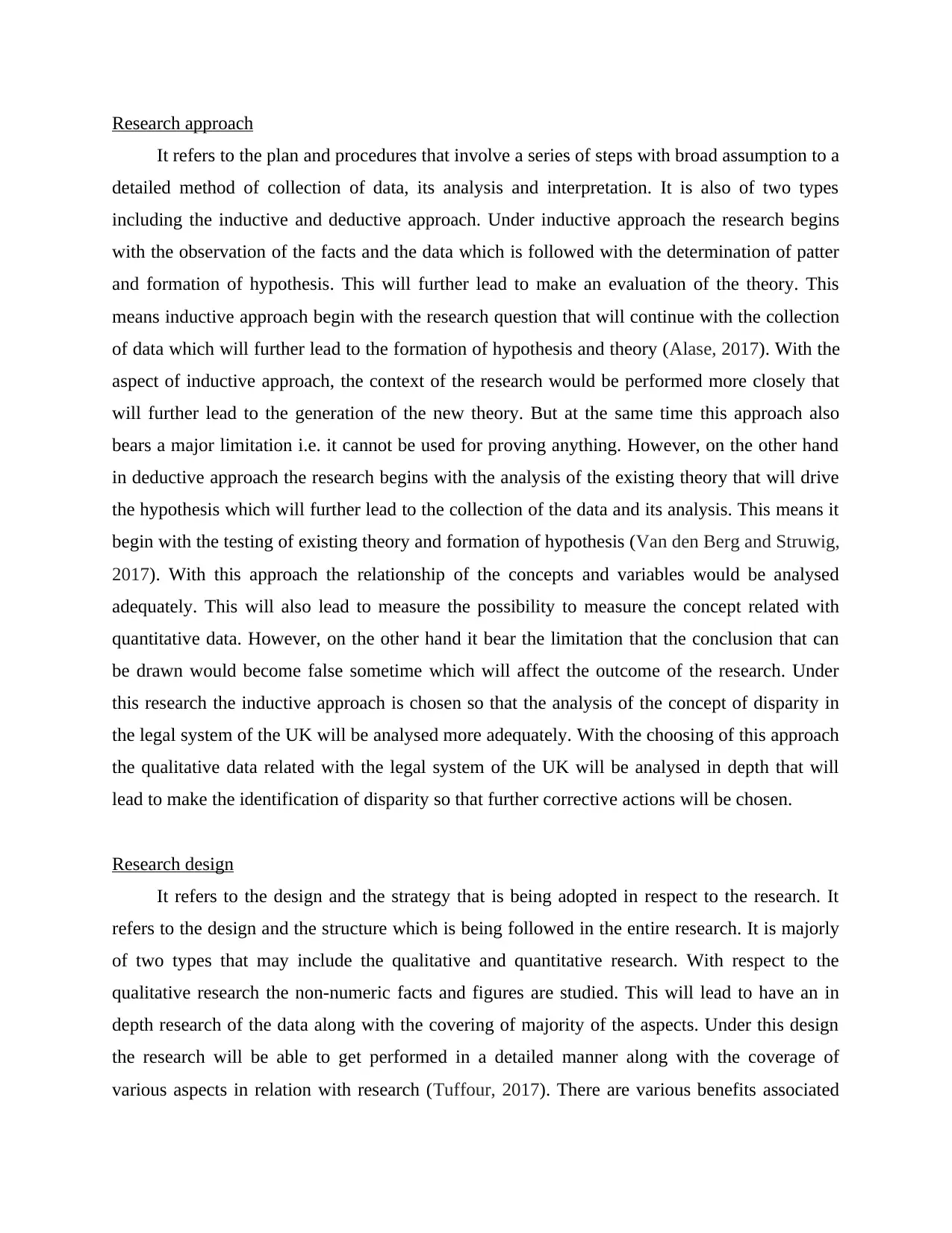
Research approach
It refers to the plan and procedures that involve a series of steps with broad assumption to a
detailed method of collection of data, its analysis and interpretation. It is also of two types
including the inductive and deductive approach. Under inductive approach the research begins
with the observation of the facts and the data which is followed with the determination of patter
and formation of hypothesis. This will further lead to make an evaluation of the theory. This
means inductive approach begin with the research question that will continue with the collection
of data which will further lead to the formation of hypothesis and theory (Alase, 2017). With the
aspect of inductive approach, the context of the research would be performed more closely that
will further lead to the generation of the new theory. But at the same time this approach also
bears a major limitation i.e. it cannot be used for proving anything. However, on the other hand
in deductive approach the research begins with the analysis of the existing theory that will drive
the hypothesis which will further lead to the collection of the data and its analysis. This means it
begin with the testing of existing theory and formation of hypothesis (Van den Berg and Struwig,
2017). With this approach the relationship of the concepts and variables would be analysed
adequately. This will also lead to measure the possibility to measure the concept related with
quantitative data. However, on the other hand it bear the limitation that the conclusion that can
be drawn would become false sometime which will affect the outcome of the research. Under
this research the inductive approach is chosen so that the analysis of the concept of disparity in
the legal system of the UK will be analysed more adequately. With the choosing of this approach
the qualitative data related with the legal system of the UK will be analysed in depth that will
lead to make the identification of disparity so that further corrective actions will be chosen.
Research design
It refers to the design and the strategy that is being adopted in respect to the research. It
refers to the design and the structure which is being followed in the entire research. It is majorly
of two types that may include the qualitative and quantitative research. With respect to the
qualitative research the non-numeric facts and figures are studied. This will lead to have an in
depth research of the data along with the covering of majority of the aspects. Under this design
the research will be able to get performed in a detailed manner along with the coverage of
various aspects in relation with research (Tuffour, 2017). There are various benefits associated
It refers to the plan and procedures that involve a series of steps with broad assumption to a
detailed method of collection of data, its analysis and interpretation. It is also of two types
including the inductive and deductive approach. Under inductive approach the research begins
with the observation of the facts and the data which is followed with the determination of patter
and formation of hypothesis. This will further lead to make an evaluation of the theory. This
means inductive approach begin with the research question that will continue with the collection
of data which will further lead to the formation of hypothesis and theory (Alase, 2017). With the
aspect of inductive approach, the context of the research would be performed more closely that
will further lead to the generation of the new theory. But at the same time this approach also
bears a major limitation i.e. it cannot be used for proving anything. However, on the other hand
in deductive approach the research begins with the analysis of the existing theory that will drive
the hypothesis which will further lead to the collection of the data and its analysis. This means it
begin with the testing of existing theory and formation of hypothesis (Van den Berg and Struwig,
2017). With this approach the relationship of the concepts and variables would be analysed
adequately. This will also lead to measure the possibility to measure the concept related with
quantitative data. However, on the other hand it bear the limitation that the conclusion that can
be drawn would become false sometime which will affect the outcome of the research. Under
this research the inductive approach is chosen so that the analysis of the concept of disparity in
the legal system of the UK will be analysed more adequately. With the choosing of this approach
the qualitative data related with the legal system of the UK will be analysed in depth that will
lead to make the identification of disparity so that further corrective actions will be chosen.
Research design
It refers to the design and the strategy that is being adopted in respect to the research. It
refers to the design and the structure which is being followed in the entire research. It is majorly
of two types that may include the qualitative and quantitative research. With respect to the
qualitative research the non-numeric facts and figures are studied. This will lead to have an in
depth research of the data along with the covering of majority of the aspects. Under this design
the research will be able to get performed in a detailed manner along with the coverage of
various aspects in relation with research (Tuffour, 2017). There are various benefits associated
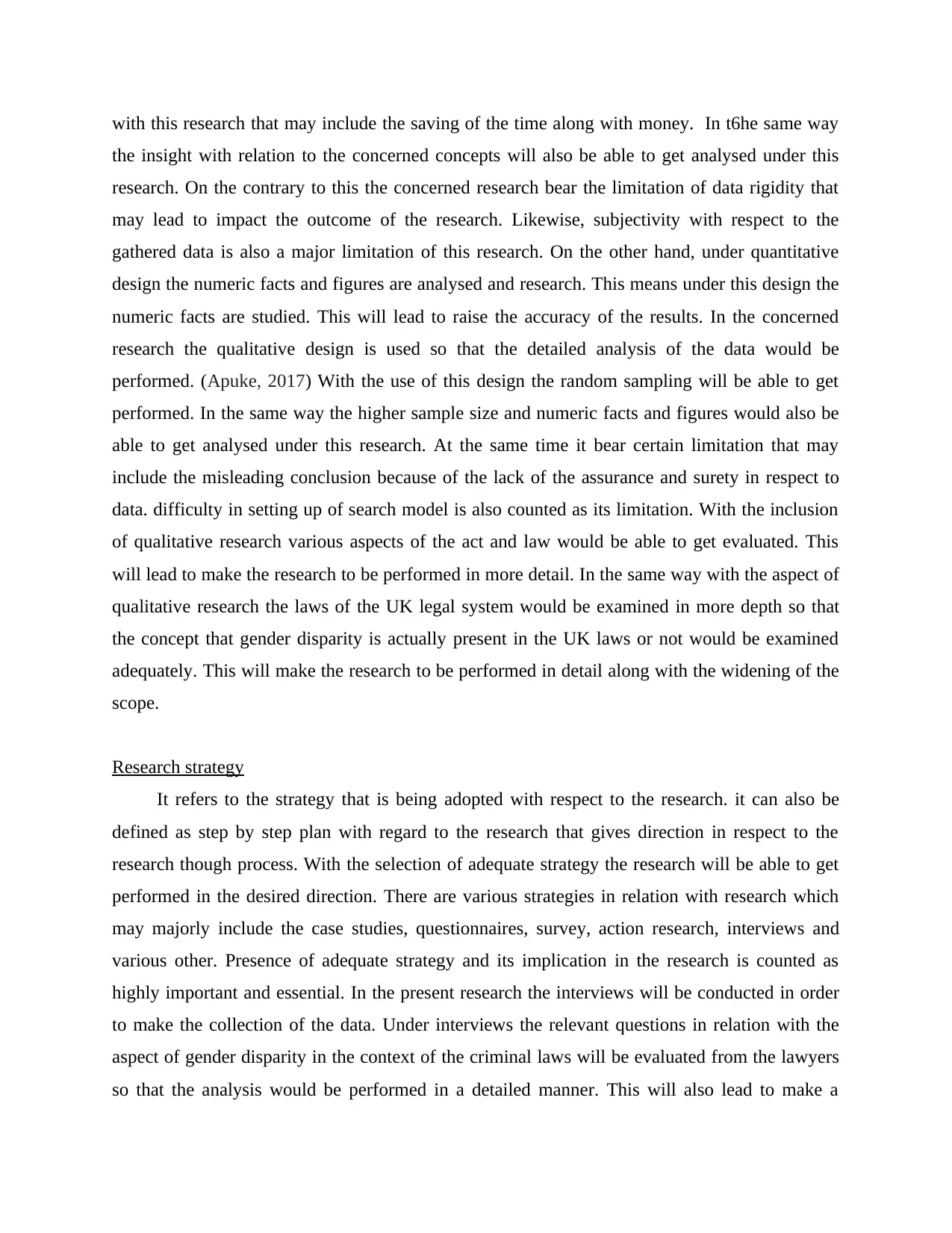
with this research that may include the saving of the time along with money. In t6he same way
the insight with relation to the concerned concepts will also be able to get analysed under this
research. On the contrary to this the concerned research bear the limitation of data rigidity that
may lead to impact the outcome of the research. Likewise, subjectivity with respect to the
gathered data is also a major limitation of this research. On the other hand, under quantitative
design the numeric facts and figures are analysed and research. This means under this design the
numeric facts are studied. This will lead to raise the accuracy of the results. In the concerned
research the qualitative design is used so that the detailed analysis of the data would be
performed. (Apuke, 2017) With the use of this design the random sampling will be able to get
performed. In the same way the higher sample size and numeric facts and figures would also be
able to get analysed under this research. At the same time it bear certain limitation that may
include the misleading conclusion because of the lack of the assurance and surety in respect to
data. difficulty in setting up of search model is also counted as its limitation. With the inclusion
of qualitative research various aspects of the act and law would be able to get evaluated. This
will lead to make the research to be performed in more detail. In the same way with the aspect of
qualitative research the laws of the UK legal system would be examined in more depth so that
the concept that gender disparity is actually present in the UK laws or not would be examined
adequately. This will make the research to be performed in detail along with the widening of the
scope.
Research strategy
It refers to the strategy that is being adopted with respect to the research. it can also be
defined as step by step plan with regard to the research that gives direction in respect to the
research though process. With the selection of adequate strategy the research will be able to get
performed in the desired direction. There are various strategies in relation with research which
may majorly include the case studies, questionnaires, survey, action research, interviews and
various other. Presence of adequate strategy and its implication in the research is counted as
highly important and essential. In the present research the interviews will be conducted in order
to make the collection of the data. Under interviews the relevant questions in relation with the
aspect of gender disparity in the context of the criminal laws will be evaluated from the lawyers
so that the analysis would be performed in a detailed manner. This will also lead to make a
the insight with relation to the concerned concepts will also be able to get analysed under this
research. On the contrary to this the concerned research bear the limitation of data rigidity that
may lead to impact the outcome of the research. Likewise, subjectivity with respect to the
gathered data is also a major limitation of this research. On the other hand, under quantitative
design the numeric facts and figures are analysed and research. This means under this design the
numeric facts are studied. This will lead to raise the accuracy of the results. In the concerned
research the qualitative design is used so that the detailed analysis of the data would be
performed. (Apuke, 2017) With the use of this design the random sampling will be able to get
performed. In the same way the higher sample size and numeric facts and figures would also be
able to get analysed under this research. At the same time it bear certain limitation that may
include the misleading conclusion because of the lack of the assurance and surety in respect to
data. difficulty in setting up of search model is also counted as its limitation. With the inclusion
of qualitative research various aspects of the act and law would be able to get evaluated. This
will lead to make the research to be performed in more detail. In the same way with the aspect of
qualitative research the laws of the UK legal system would be examined in more depth so that
the concept that gender disparity is actually present in the UK laws or not would be examined
adequately. This will make the research to be performed in detail along with the widening of the
scope.
Research strategy
It refers to the strategy that is being adopted with respect to the research. it can also be
defined as step by step plan with regard to the research that gives direction in respect to the
research though process. With the selection of adequate strategy the research will be able to get
performed in the desired direction. There are various strategies in relation with research which
may majorly include the case studies, questionnaires, survey, action research, interviews and
various other. Presence of adequate strategy and its implication in the research is counted as
highly important and essential. In the present research the interviews will be conducted in order
to make the collection of the data. Under interviews the relevant questions in relation with the
aspect of gender disparity in the context of the criminal laws will be evaluated from the lawyers
so that the analysis would be performed in a detailed manner. This will also lead to make a
Paraphrase This Document
Need a fresh take? Get an instant paraphrase of this document with our AI Paraphraser
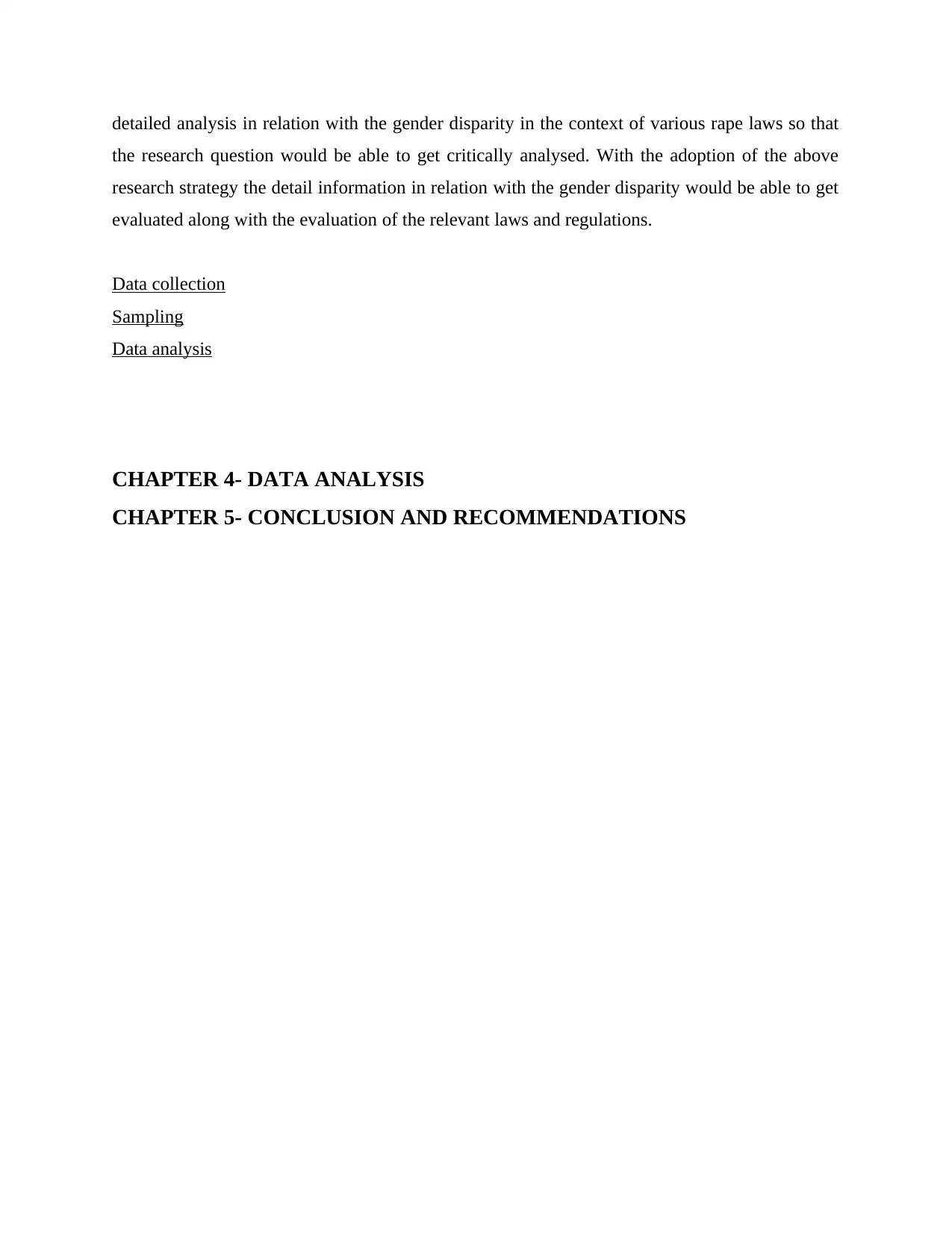
detailed analysis in relation with the gender disparity in the context of various rape laws so that
the research question would be able to get critically analysed. With the adoption of the above
research strategy the detail information in relation with the gender disparity would be able to get
evaluated along with the evaluation of the relevant laws and regulations.
Data collection
Sampling
Data analysis
CHAPTER 4- DATA ANALYSIS
CHAPTER 5- CONCLUSION AND RECOMMENDATIONS
the research question would be able to get critically analysed. With the adoption of the above
research strategy the detail information in relation with the gender disparity would be able to get
evaluated along with the evaluation of the relevant laws and regulations.
Data collection
Sampling
Data analysis
CHAPTER 4- DATA ANALYSIS
CHAPTER 5- CONCLUSION AND RECOMMENDATIONS
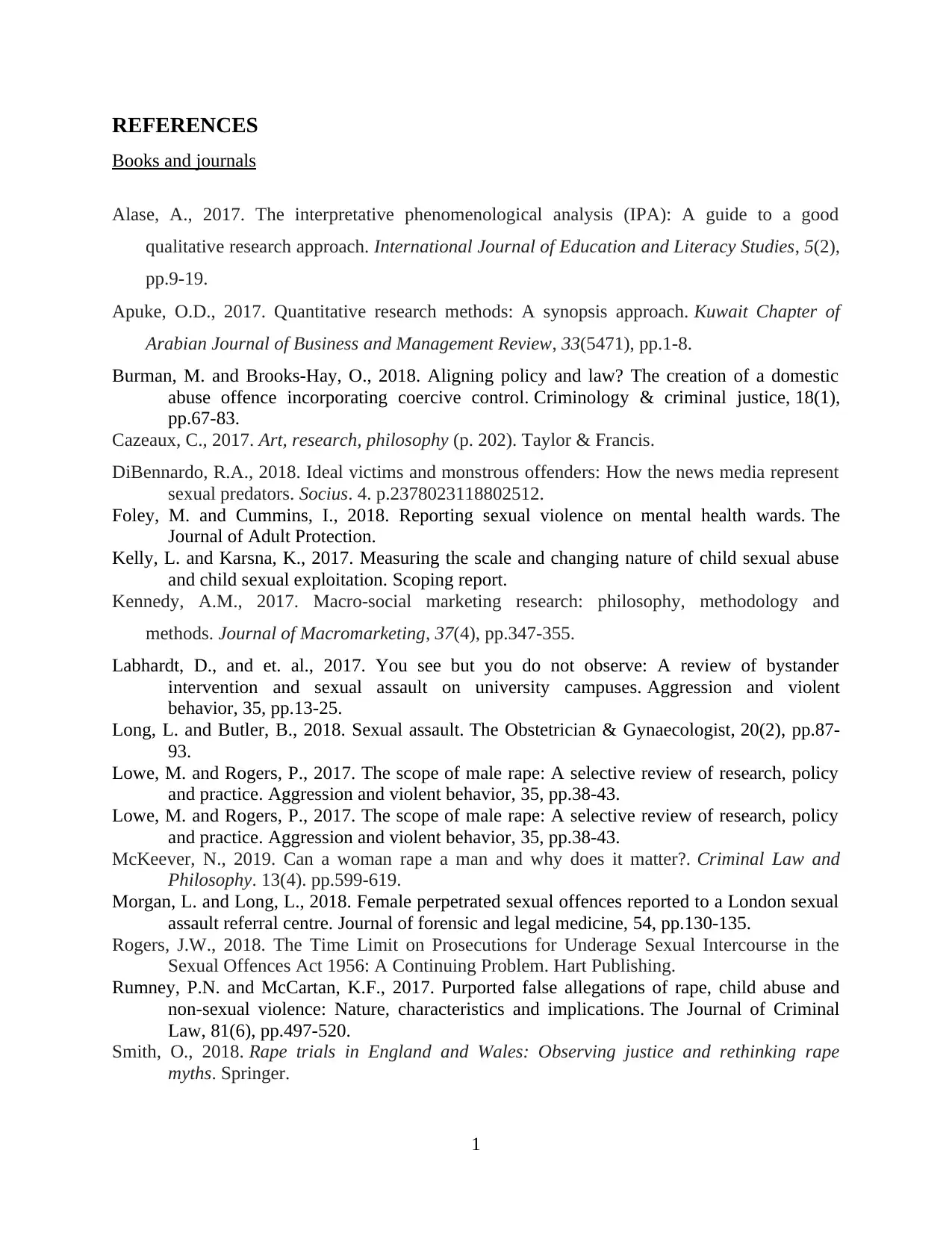
REFERENCES
Books and journals
Alase, A., 2017. The interpretative phenomenological analysis (IPA): A guide to a good
qualitative research approach. International Journal of Education and Literacy Studies, 5(2),
pp.9-19.
Apuke, O.D., 2017. Quantitative research methods: A synopsis approach. Kuwait Chapter of
Arabian Journal of Business and Management Review, 33(5471), pp.1-8.
Burman, M. and Brooks-Hay, O., 2018. Aligning policy and law? The creation of a domestic
abuse offence incorporating coercive control. Criminology & criminal justice, 18(1),
pp.67-83.
Cazeaux, C., 2017. Art, research, philosophy (p. 202). Taylor & Francis.
DiBennardo, R.A., 2018. Ideal victims and monstrous offenders: How the news media represent
sexual predators. Socius. 4. p.2378023118802512.
Foley, M. and Cummins, I., 2018. Reporting sexual violence on mental health wards. The
Journal of Adult Protection.
Kelly, L. and Karsna, K., 2017. Measuring the scale and changing nature of child sexual abuse
and child sexual exploitation. Scoping report.
Kennedy, A.M., 2017. Macro-social marketing research: philosophy, methodology and
methods. Journal of Macromarketing, 37(4), pp.347-355.
Labhardt, D., and et. al., 2017. You see but you do not observe: A review of bystander
intervention and sexual assault on university campuses. Aggression and violent
behavior, 35, pp.13-25.
Long, L. and Butler, B., 2018. Sexual assault. The Obstetrician & Gynaecologist, 20(2), pp.87-
93.
Lowe, M. and Rogers, P., 2017. The scope of male rape: A selective review of research, policy
and practice. Aggression and violent behavior, 35, pp.38-43.
Lowe, M. and Rogers, P., 2017. The scope of male rape: A selective review of research, policy
and practice. Aggression and violent behavior, 35, pp.38-43.
McKeever, N., 2019. Can a woman rape a man and why does it matter?. Criminal Law and
Philosophy. 13(4). pp.599-619.
Morgan, L. and Long, L., 2018. Female perpetrated sexual offences reported to a London sexual
assault referral centre. Journal of forensic and legal medicine, 54, pp.130-135.
Rogers, J.W., 2018. The Time Limit on Prosecutions for Underage Sexual Intercourse in the
Sexual Offences Act 1956: A Continuing Problem. Hart Publishing.
Rumney, P.N. and McCartan, K.F., 2017. Purported false allegations of rape, child abuse and
non-sexual violence: Nature, characteristics and implications. The Journal of Criminal
Law, 81(6), pp.497-520.
Smith, O., 2018. Rape trials in England and Wales: Observing justice and rethinking rape
myths. Springer.
1
Books and journals
Alase, A., 2017. The interpretative phenomenological analysis (IPA): A guide to a good
qualitative research approach. International Journal of Education and Literacy Studies, 5(2),
pp.9-19.
Apuke, O.D., 2017. Quantitative research methods: A synopsis approach. Kuwait Chapter of
Arabian Journal of Business and Management Review, 33(5471), pp.1-8.
Burman, M. and Brooks-Hay, O., 2018. Aligning policy and law? The creation of a domestic
abuse offence incorporating coercive control. Criminology & criminal justice, 18(1),
pp.67-83.
Cazeaux, C., 2017. Art, research, philosophy (p. 202). Taylor & Francis.
DiBennardo, R.A., 2018. Ideal victims and monstrous offenders: How the news media represent
sexual predators. Socius. 4. p.2378023118802512.
Foley, M. and Cummins, I., 2018. Reporting sexual violence on mental health wards. The
Journal of Adult Protection.
Kelly, L. and Karsna, K., 2017. Measuring the scale and changing nature of child sexual abuse
and child sexual exploitation. Scoping report.
Kennedy, A.M., 2017. Macro-social marketing research: philosophy, methodology and
methods. Journal of Macromarketing, 37(4), pp.347-355.
Labhardt, D., and et. al., 2017. You see but you do not observe: A review of bystander
intervention and sexual assault on university campuses. Aggression and violent
behavior, 35, pp.13-25.
Long, L. and Butler, B., 2018. Sexual assault. The Obstetrician & Gynaecologist, 20(2), pp.87-
93.
Lowe, M. and Rogers, P., 2017. The scope of male rape: A selective review of research, policy
and practice. Aggression and violent behavior, 35, pp.38-43.
Lowe, M. and Rogers, P., 2017. The scope of male rape: A selective review of research, policy
and practice. Aggression and violent behavior, 35, pp.38-43.
McKeever, N., 2019. Can a woman rape a man and why does it matter?. Criminal Law and
Philosophy. 13(4). pp.599-619.
Morgan, L. and Long, L., 2018. Female perpetrated sexual offences reported to a London sexual
assault referral centre. Journal of forensic and legal medicine, 54, pp.130-135.
Rogers, J.W., 2018. The Time Limit on Prosecutions for Underage Sexual Intercourse in the
Sexual Offences Act 1956: A Continuing Problem. Hart Publishing.
Rumney, P.N. and McCartan, K.F., 2017. Purported false allegations of rape, child abuse and
non-sexual violence: Nature, characteristics and implications. The Journal of Criminal
Law, 81(6), pp.497-520.
Smith, O., 2018. Rape trials in England and Wales: Observing justice and rethinking rape
myths. Springer.
1
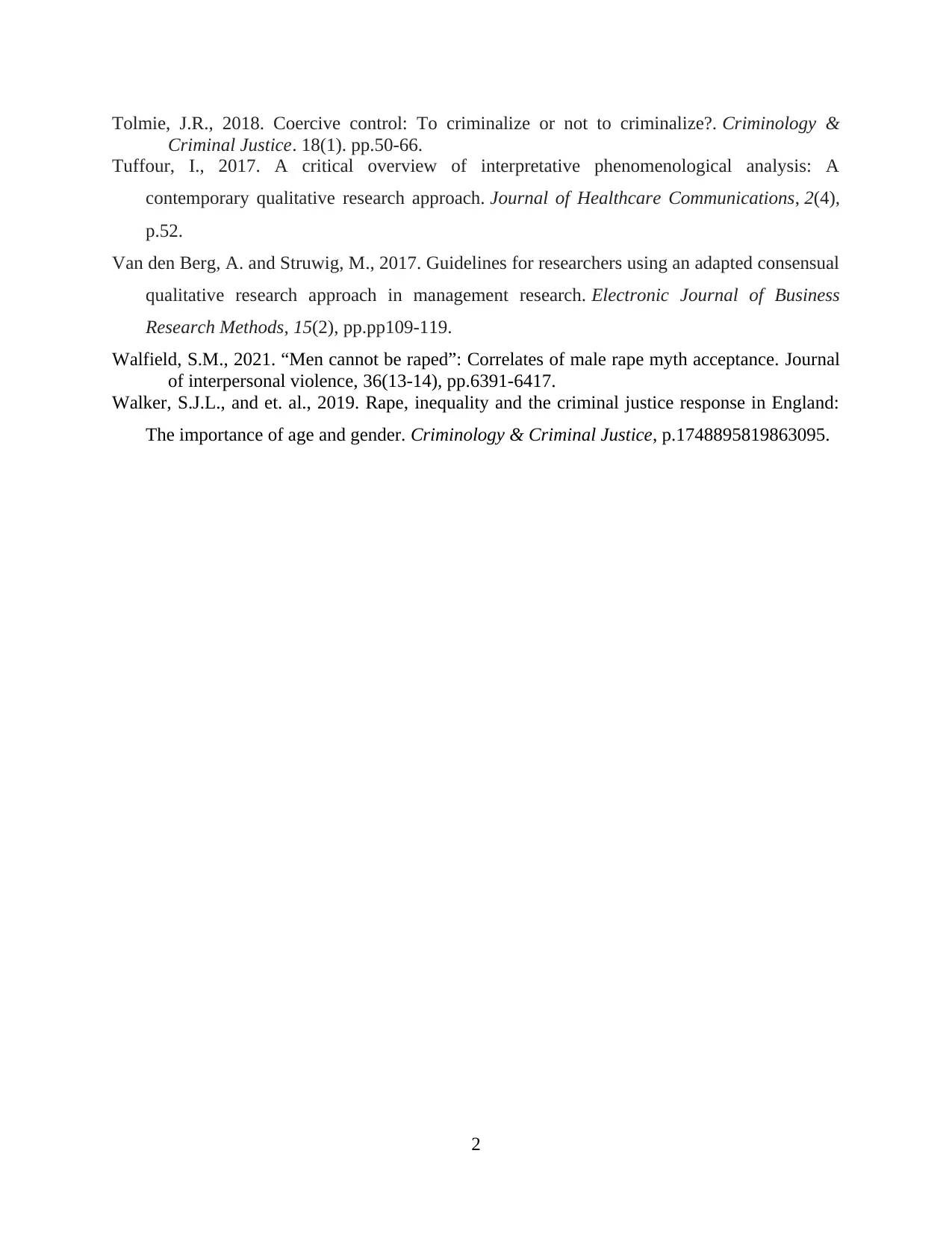
Tolmie, J.R., 2018. Coercive control: To criminalize or not to criminalize?. Criminology &
Criminal Justice. 18(1). pp.50-66.
Tuffour, I., 2017. A critical overview of interpretative phenomenological analysis: A
contemporary qualitative research approach. Journal of Healthcare Communications, 2(4),
p.52.
Van den Berg, A. and Struwig, M., 2017. Guidelines for researchers using an adapted consensual
qualitative research approach in management research. Electronic Journal of Business
Research Methods, 15(2), pp.pp109-119.
Walfield, S.M., 2021. “Men cannot be raped”: Correlates of male rape myth acceptance. Journal
of interpersonal violence, 36(13-14), pp.6391-6417.
Walker, S.J.L., and et. al., 2019. Rape, inequality and the criminal justice response in England:
The importance of age and gender. Criminology & Criminal Justice, p.1748895819863095.
2
Criminal Justice. 18(1). pp.50-66.
Tuffour, I., 2017. A critical overview of interpretative phenomenological analysis: A
contemporary qualitative research approach. Journal of Healthcare Communications, 2(4),
p.52.
Van den Berg, A. and Struwig, M., 2017. Guidelines for researchers using an adapted consensual
qualitative research approach in management research. Electronic Journal of Business
Research Methods, 15(2), pp.pp109-119.
Walfield, S.M., 2021. “Men cannot be raped”: Correlates of male rape myth acceptance. Journal
of interpersonal violence, 36(13-14), pp.6391-6417.
Walker, S.J.L., and et. al., 2019. Rape, inequality and the criminal justice response in England:
The importance of age and gender. Criminology & Criminal Justice, p.1748895819863095.
2
1 out of 16
Your All-in-One AI-Powered Toolkit for Academic Success.
+13062052269
info@desklib.com
Available 24*7 on WhatsApp / Email
![[object Object]](/_next/static/media/star-bottom.7253800d.svg)
Unlock your academic potential
© 2024 | Zucol Services PVT LTD | All rights reserved.

